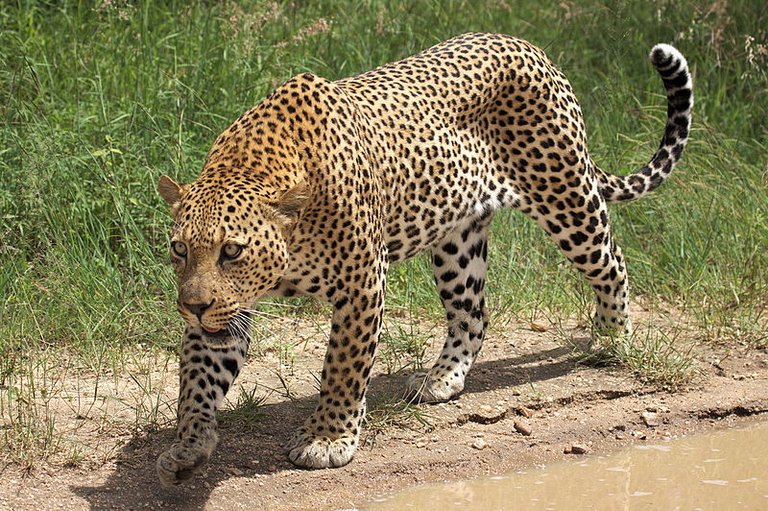Leopards are beautiful and powerful big cats closely related to lions, tigers and jaguars. They live in Sub-Saharan Africa, Northeast Africa, Central Asia, India and China. However, many of their populations are endangered, especially outside Africa.
Leopard, (Panthera pardus), formerly Pard or Pardus, also known as Panther. This big cat is closely related to lions, tigers and jaguars. The leopard was originally named for the cat now called the cheetah - the so-called hunting leopard - which was once considered a cross between a lion and a pard. The word Pard was eventually renamed as leopard.

Source
Leopards are well known for their cream and gold spotted fur, but some leopards have dark spots. These black leopards are often mistaken for panthers.
Adult leopards are solitary animals. Each adult leopard has its own area where it lives and, although they often share parts of it, they try to avoid each other.
The leopard's body is designed for hunting. They have sleek, powerful bodies and can run at speeds up to 57 kilometers per hour. They are also excellent swimmers and climbers and can jump and jump long distances.
A leopard's tail is as long as its entire body. This helps to balance it and enables it to accelerate quickly.
Leopards hunt mostly at night.

Source
Leopards preserve their food from other animals by pulling them to a height on the trees. A leopard often leaves its prey in the tree for days and returns only when it is hungry!
Female leopards give birth to two or three cubs at a time. Until a cub is two years old. He would then leave his mother's company and survive on his own.
When a female leopard is ready to orgasm she will give an odor and rub her body on the trees to release her smell. Male leopards either smell the female odor or hear her call that she is ready to orgasm.
Distribution of Leopards
In 1750 the geographical range of leopards occupied almost the whole of South Africa, parts of Sahara, North and North-East Africa, and extended from Asia Minor to Central Asia and from India to China and Manchuria.
By 2015, the species had reduced to around 75 percent. However, with small populations spread across Central Asia, India, Southeast Asia, East China and Manchuria, and the Korean Peninsula, many large pockets remained throughout sub-Saharan Africa, Iran, and the Himalayas. In addition, a small pocket of leopards persists in the Atlas Mountains.

Source
Leopard varies greatly in size and markings. Average size in weight is 50 to 90 kg (110 to 200 lb), 210 cm (84 in), 60 to 70 cm in shoulder height, except for a tail of 90 cm in length. However, the leopard may be much larger. The color of the ground is usually yellow from the top and white at the bottom. Dark spots are usually arranged in the very part of the body and are without the central spot characteristic of the jaguar's coat; The ground color within rosettes is sometimes dark yellow, and the size and spacing of the spots varies greatly. As a result of these differences in patterns, several species of leopards have been designated.
The leopard is a solitary animal of the bush and forest and is mainly nocturnal in habitat, although it sometimes lives in the sun. It is an agile climber and often stores the remains of its prey in tree branches. It can eat any animal, it can eat from small rodents to waterbuck, but usually preys on small and medium sized antelopes and deer; In Africa, it is particularly fond of dogs as a food for baboons. It can sometimes attack humans.
There is no fixed breeding season; The female produces two to four, usually three, cubs after a period of about three months.
What do leopards look like?
Most leopards are quite light in color and have dark spots on their fur. These spots are actually called 'rosettes' because they look like roses in shape.
Do you know that black leopards also occur? But their spots look very difficult because they are so black!
You will find leopards from all over the world including Sub-Saharan Africa, Northeast Africa, Central Asia, India and China.
Hunting skills
The leopard is so strong and comfortable in trees that it often draws prey in its branches. Pulling the bodies of large animals, it hopes to protect them from scavengers such as hyenas. Leopards can also hunt from trees, where their spotted coat allows them to blend in with the leaves until they come with a deadly boom. These nocturnal predators hunt antelope, deer and pigs by stealthy movement in the tall grass. When human settlements are present, leopards often attack dogs and, sometimes, people.
Leopards are strong swimmers and are very much at home in the water, where they occasionally eat fish or crabs.
@orion7


You got a 31.41% upvote from @joeparys! Thank you for your support of our services. To continue your support, please follow and delegate Steem power to @joeparys for daily steem and steem dollar payouts!
You got a 50.00% upvote from @redlambo courtesy of @orion7! Make sure to use tag #redlambo to be considered for the curation post!
You got a 50.00% upvote from @bid4joy courtesy of @orion7!
You got a 13.20% upvote from @minnowvotes courtesy of @orion7!
Hello @orion7, thank you for sharing this creative work! We just stopped by to say that you've been upvoted by the @creativecrypto magazine. The Creative Crypto is all about art on the blockchain and learning from creatives like you. Looking forward to crossing paths again soon. Steem on!
Defended (49.50%)
Summoned by @orion7
Sneaky Ninja supports @youarehope and @tarc with a percentage of all bids.
Everything You Need To Know About Sneaky Ninja
woosh